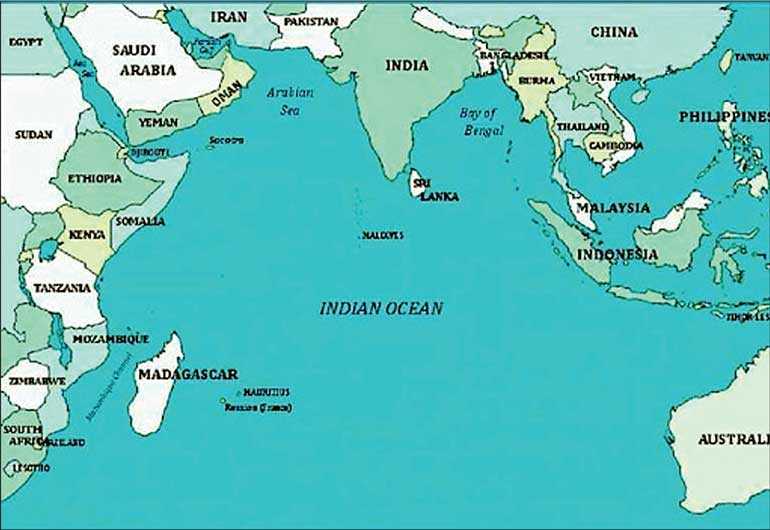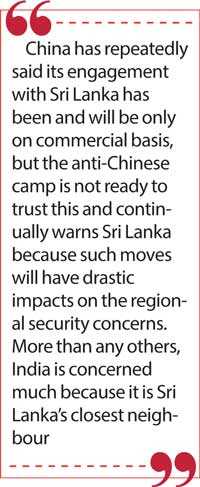Tuesday Dec 30, 2025
Tuesday Dec 30, 2025
Wednesday, 21 October 2020 00:04 - - {{hitsCtrl.values.hits}}

Sri Lanka’s strategic location in the Indian Ocean has resulted in it becoming a sprat among furious and fighting sharks
When the US Envoy for Sri Lanka spoke about China’s lack of transparency in a local newspaper, the Chinese Embassy in Colombo responded and said: “We strongly suggest the US quit the addiction of  preaching others and applying double standards.”
preaching others and applying double standards.”
In an interview with Sri Lanka’s Daily Mirror, the United States Ambassador to Sri Lanka and Maldives Alaina B. Teplitz was quoted as saying “Sri Lanka should engage with China in ways that protect its sovereignty”.
Teplitz in the interview published on 5 October also said the US would encourage it if China’s relationship with Sri Lanka was transparent and mutually beneficial, and Sri Lanka must not be vulnerable in its relationships. Quoting a 2019 study, she also said the World Bank had concluded that 60% of China-funded Belt and Road Initiative (BRI) projects were allocated to Chinese companies and tender processes were opaque.
The Chinese Embassy in Colombo took no time to respond to Teplitz’s comments. It was furious. In its official statement, the Chinese Embassy said: “With great shock and strong discontent, the embassy learned about the US Ambassador’s interview with a local newspaper, in which a foreign envoy from a third country openly played off China-Sri Lanka relations and severely violated the diplomatic protocol.”
This is not the first time both international powers collide in Sri Lanka. But this is the first time both US and Chinese Embassies and top officials in Sri Lanka have engaged in words of war through statements, using their diplomatic missions.
Sri Lanka’s strategic location in the Indian Ocean has resulted in it becoming a sprat among furious and fighting sharks.
It’s no more secret and unofficial. Both China and US have started the cold war in Sri Lankan soil openly, accusing each other through official statements and social media. The recent unfolding events suggest both world’s top largest economies are up to cut the throats of each other.
It’s not something new. It gradually started since the end of the war as China suddenly became one of Sri Lanka’s main lenders when nobody was willing to grant money because of the island nation’s alleged poor human rights records in the final phase of the 26-year war that ended in 2009.
Warning on Port City company
Before the outburst by the US envoy, the US Embassy in Colombo issued a statement nine days after the US Department of State imposed visa restrictions on select Chinese individuals, who the US claimed to be ‘responsible for, or complicit in, either the large-scale reclamation, construction, or militarisation of disputed outposts in the South China Sea’, or the People’s Republic of China’s (PRC) use of coercion against Southeast Asian claimants to inhibit their access to offshore resources.
In addition, the Department of Commerce added 24 Chinese State-Owned Enterprises to the Entity List, including several subsidiaries of China Communications Construction Company (CCCC), Sri Lanka’s Port City construction company.
The embassy further said since 2013, China has used its State-Owned Enterprises to dredge and unlawfully reclaim more than 3,000 acres in the South China Sea, destabilising the region, trampling on the sovereign rights of its neighbours, and causing untold environmental devastation.
“CCCC led the destructive dredging of the PRC’s South China Sea outposts and is also one of the leading contractors used by Beijing in its global Belt and Road Initiative (BRI) strategy. CCCC and its subsidiaries have engaged in corruption, predatory financing, environmental destruction, and other abuses across the world,” the US Embassy in Colombo said in its statement, directly attacking one of the key Chinese state-owned firm.
It also said: “The United States further encourages countries to manage risk when dealing with CCCC and its subsidiaries”, in a message to Sri Lanka. “The United States hopes countries will examine their dealings with CCCC to guard against the company’s abuses, and to protect their own sovereignty and interests.”
Chinese Embassy Spokesman in Colombo Luo Chong said the US Embassy had to clarify the statement on CCCC.
“I think it’s the US Embassy that should provide Colombo further clarification especially on whether Sri Lanka should be included in such unilateral sanctions imposed by the US government on Chinese companies and what exactly the sanctions are, as well as the possible impact if a sovereign nation like Sri Lanka refuses to imply on its territory,” Chong said.
The Chinese Embassy in Colombo in a separate statement said the sanctions were “totally against the truth and violating international law and norms”.
“China firmly opposes it, and has urged the US administration to rectify its mistakes and immediately stop interfering in China’s internal affairs….Such unilateral and unjust sanctions from the US that severely intervene other sovereign countries’ internal affairs have no international legal effect at all and should not be accepted and tolerated.”
It also said: “We understand that the US is facing quite a few domestic challenges including anti-racism, economy revival and COVID-19 pandemic, and we hope the US administration could concentrate more on its internal problems, listen to the voice of the global community, honour the multilateralism and  international justice and order, make its due contribution to the social-economic development of the world, and bring more benefits to its own people and other developing countries including Sri Lanka.”
international justice and order, make its due contribution to the social-economic development of the world, and bring more benefits to its own people and other developing countries including Sri Lanka.”
Through these statements, both China and the US Embassies in Colombo have blamed each other in an undiplomatic manner, other diplomats in Sri Lanka say.
They fight through statements in Sri Lanka because President Gotabaya Rajapaksa’s administration has sought Chinese help for funding and China has agreed to help through loans. Other international powers are unable to help Sri Lanka with loans because Sri Lankan Government does not want many conditions attached to the loans.
Sri Lanka, however, has been repeatedly warned by anti-Chinese camp of China’s ‘debt-trap diplomacy’ which means owning the infrastructure built by Beijing loans when the respective country finds it is unable to repay the loans as agreed. Sri Lanka has already leased its Hambantota port on a 99-year lease on a debt-to-equity deal. The anti-Chinese camp has also given several South African experiences of how debt-trap diplomacy has worked.
Unplanned visits
When four world powers – US, India, Japan, and Australia – met on 6 October in Tokyo for an ‘exclusive clique’ quadrilateral (Quad) meeting to discuss about China, President Xi Jinping sent a delegation led by former Chinese Foreign Minister and the current Communist Party Political Bureau Member Yang Jiechi, raising the eyebrows of many.
The meeting of the foreign ministers of the four international powers was an attempt to bolster a nascent alliance of democracies to counter China’s growing assertiveness.
China has pursued an increasingly aggressive foreign policy under President Xi Jinping, while the Trump administration has identified Communist Party rule as a threat to US interests.
The Chinese delegation’s visit was facilitated with a travel bubble, which means with no quarantine the visit was confined to Colombo and restrict their engagements to just two meetings under the strict health protocol prescribed by the Ministry of Health.
The meeting between Yang and Sri Lankan leaders have resulted in a $ 90 million grant and further discussion for loans.
And soon after his visit, the Government officials say US Secretary to State Mike Pampoe is expected to visit on 28 October followed by an undated visit by Indian Foreign Minister Subrahmanyam Jaishankar.
Leave alone all the conspiracy theories explaining why these top level officials are coming to Sri Lanka. But all of a sudden, Sri Lanka has become the darling of China and US.
Main concerns
For the US and its allies including India, there are two main concerns when it comes to Sri Lanka’s dealing with China. The first concern is about the regional security in the Indian Ocean and the second is Sri Lankan Government, in the event of being caught in a debt trap, dancing to the tune of China. Both could bring adverse impacts to other countries.
According to the spirit of the 1987 Indo-Lanka Accord and several joint statements issued following High Level visits between the two countries since then, Sri Lanka has to consult India in matters related to the regional security of Indian Ocean. So any matters related to China that has an impact on the regional security means India has a say.
Many see the Chinese presence in Sri Lanka as a threat to regional security. They draw parallel example from the sequence of events in the South China Sea, which involve both island and maritime claims among several sovereign states within the region, namely Brunei, People’s Republic of China, Taiwan, Indonesia, Malaysia, the Philippines, and Vietnam.
China’s request for exclusive zones in the Port City and Hambantota Economic Zone have been seen by China’s opponents as a strategy to use Sri Lanka’s strategic position for China’s own trade benefits.
China has repeatedly said its engagement with Sri Lanka has been and will be only on commercial basis, but the anti-Chinese camp is not ready to trust this and continually warns Sri Lanka because such moves will have drastic impacts on the regional security concerns.
More than any others, India is concerned much because it is Sri Lanka’s closest neighbour.
“China’s increasingly visible footprint in Sri Lanka since the return of the Rajapaksas has made India’s position a little shaky,” The Diplomat, an international current-affairs magazine for the Asia-Pacific region, says.
“China’s influence in Sri Lanka will remain a cause of concern for India. The Rajapaksas have been generally perceived as close to China. The fact that the Hambantota Port development was given to China by Mahinda Rajapaksa during his previous term in office as President continues to be a sore point for India. While this has been worrying enough, that the Sri Lankan Government signed the Hambantota Port to China on a 99-year lease is even more of a concern in New Delhi,” it said, referring to the deep southern port which was given to China on a lease for $ 1.12 billion in 2017.
Consequence of cold wars
Every time Sri Lanka was too close to one international power, there had been strong consequences, whether it was the US or China.
When J.R. Jayewardene’s administration got close to the US in late 1970s, India feared that J.R. could give Sri Lanka’s strategically located natural port in Trincomalee to be used as a naval base for the US military. This was the time when India and US were at the cold war because of US’ alliance with China and Pakistan.
Sri Lanka had earlier agreed to give the Trincomalee tank farm development project to India because of India’s fear that the original bidders, a Singapore firm, had links to the United States. Jayewardene’s decision in 1981 to lift the nine-year-old ban on foreign warships in the Trincomalee harbour was seen as a major threat to India’s hegemony in the region, particularly because the United States was the first to send warships to the port for refuelling. India feared that the Trincomalee harbour would be covertly converted into a United States naval base if it did not put pressure on Sri Lanka to give up the Singapore firm’s offer.
This along with the JR administration’s response to 1983 ethnic clashes with attacks over minority Tamils and South Indian Tamil Nadu’s agitation led Indira Gandhi’s administration to train Sri Lankan Tamil youths in South India. This is how the Liberation Tigers of Tamil Eelam (LTTE) received foreign training in India.
JR in an interview with BBC in 1985 said: “We need the support of India. Because there are training camps in India. They (LTTE) have been trained in India and they are operating from India. They move around freely in India.”
Everybody knows what happened due to the 26-year war in Sri Lanka. India, which lost its Prime Minister Rajiv Gandhi in an LTTE suicide attack in 1991, later backed Sri Lankan effort to destroy the LTTE and helped in the final phase of the war.
Similarly, when Mahinda Rajapaksa was getting too close to China in his last tenure (2010-2014) as the president, he had to pay the price. There was an unexpected regime change and Rajapaksa was shockingly unseated by his own party secretary at the poll in which international powers played a “hide and seek” role.
The Rajapaksa Government late in 2014 expelled the Colombo Station Chief of India’s spy agency in the run-up to January 2015 Presidential Election accusing him of helping the opposition to forge an unlikely alliance, Reuters said quoting political and intelligence sources in 2015.
Sri Lanka’s Sunday Times newspaper on 28 December 2014 said “links with the common opposition” had cost India’s Research and Analysis Wing (RAW) Station Chief his job in Colombo. New Delhi has officially denied any expulsion and said that transfers were routine decisions.
Rajapaksa after the 2015 defeat accused India for being behind his defeat.
“The defeat of Rajapaksa in 2015 was a democratic coup backed by international powers due to close ties with China,” a retired Sri Lankan diplomat said on condition of anonymity.
Rajapaksa’s successor, former President Maithripala Sirisena suspended all the Chinese projects and revised the Port City agreement to exclude the “exclusive Chinese zone”.
Threats remain
Sirisena also went ahead to approve US-Millennium Challenge Corporation (MCC) grant of $ 480 million and to build East Container Terminal (ECT) of Colombo port with Indian and Japanese joint venture while keeping the majority with Sri Lanka. The US was also to sign two other security pacts, namely Status of Forces Agreement (SOFA) and Acquisition and Cross Services Agreement (ACSA).
Rajapaksa’s coalition partners, who would not go beyond his word, used MCC, SOFA, and ACSA along with the ECT at their election campaign. They have vowed not to sign these pacts with the US and India.
Sri Lanka has once again dragged back to square one. Though the Government officials are still confused about their foreign policy – whether it is ‘India first’ or ‘neutral’ or ‘non-aligned’ – in reality it is seen too much closer to China. And this is at a time when Sri Lanka’s $ 84 billion economy is in doldrums and needs more investments from all over the world to revive it. Loans alone are unlikely to help Sri Lanka to come out of the looming economic crisis.
Being close to one international power has its merit in the short term, but Sri Lanka has to be mindful of the past experience. Sri Lankans cannot afford another internal conflict after two insurrections and a long civil war in the last 50 years.
“Sri Lanka has faced similar challenges in its history. Some governments were smart enough to pursue Sri Lankan interest from all international powers without taking sides. Some governments sided with one international power while neglecting others and the Sri Lankan public had to pay the price,” said a former career diplomat who had served both Asian and Western region.
“It all depends on how the government in power plays the country’s strategic position to balance all the international powers without falling into any traps.”
It will be the sprat which will be injured or damaged at the end when it is caught among big fighting sharks. Sri Lanka is a sprat and big sharks are the international powers.
(The writer is former Reuters Economic Reporter for Sri Lanka and current Head of Training at Center for Investigative Reporting Sri Lanka. He can be reached at [email protected].)